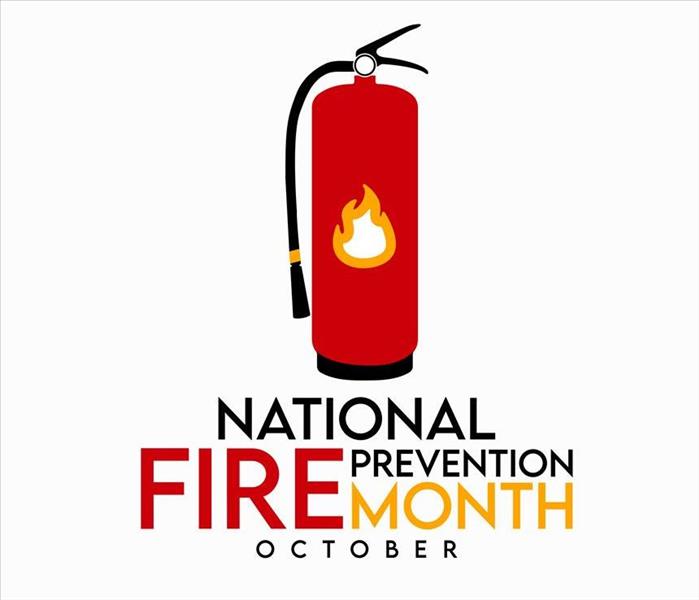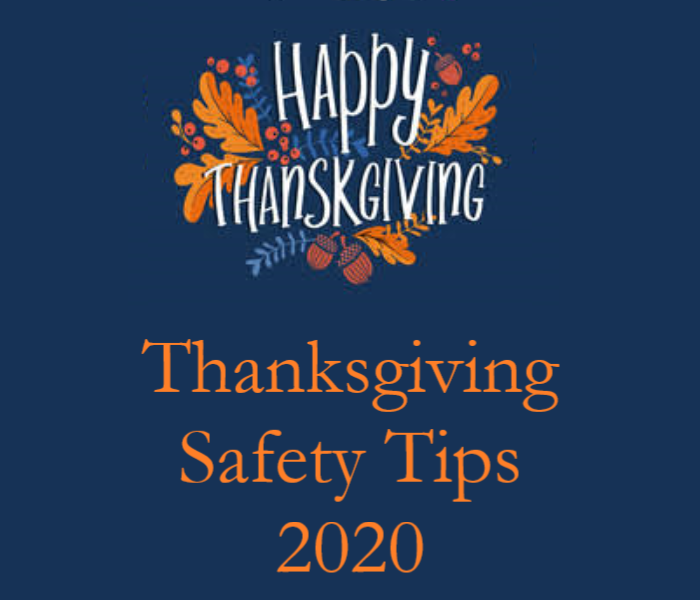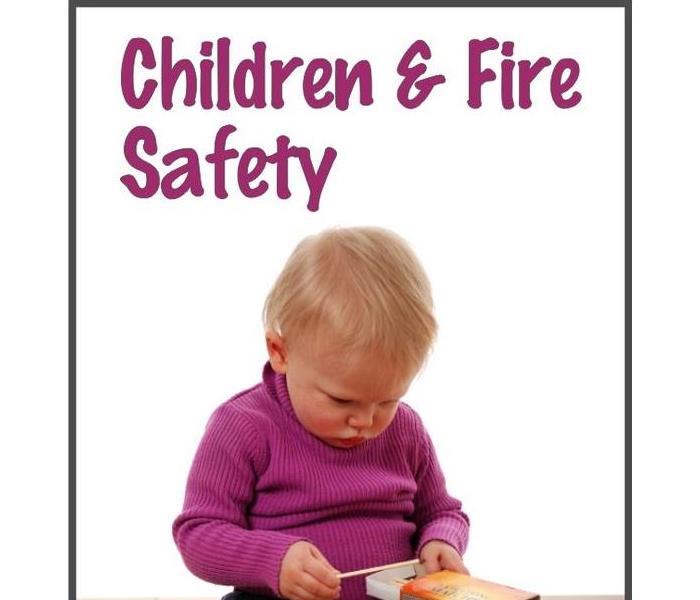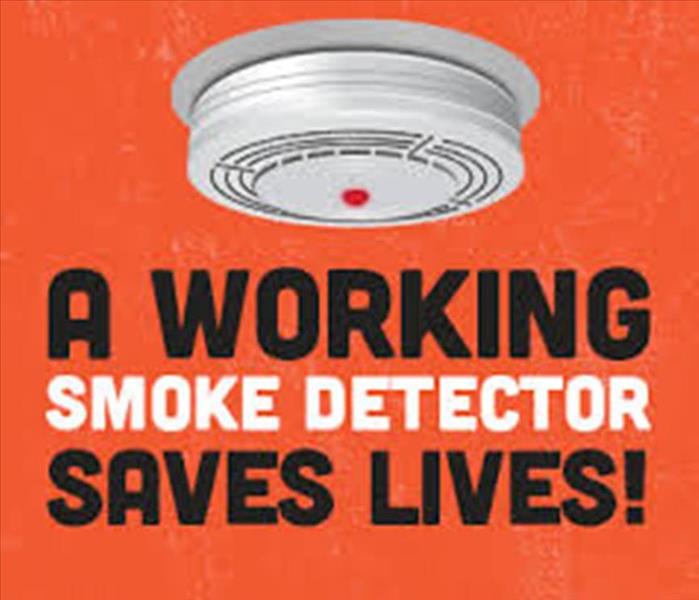Archived Fire Damage Blog Posts
SERVPRO Offers Reliable and Efficient Fire Restoration in Waldorf
10/1/2024 (Permalink)
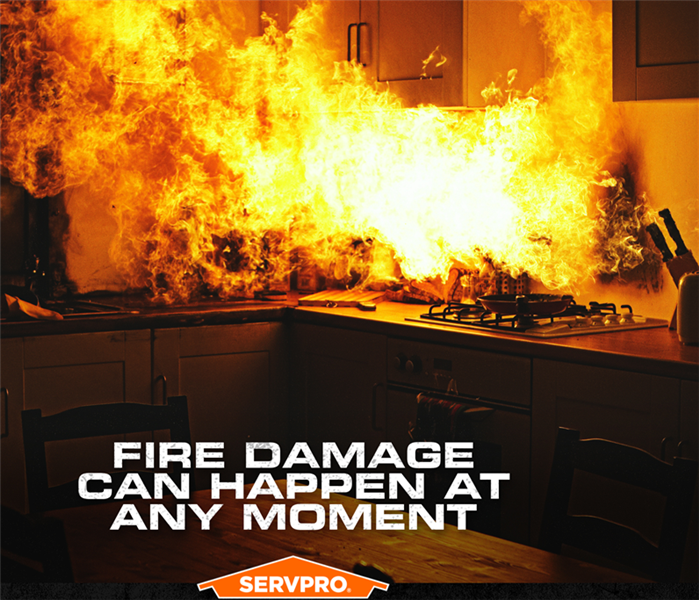 Team SERVPRO has the certification, experience and the tools to tackle the fire damage situation in your home. Contact us day or night, 24/7.
Team SERVPRO has the certification, experience and the tools to tackle the fire damage situation in your home. Contact us day or night, 24/7.
Waldorf Residents Trust SERVPRO® with Fire Restoration
Repairing fire damage to your property requires experience, attention to detail, and the right tools. When you hire professionals like SERVPRO for the fire restoration of your Waldorf home, you can limit the extent of the damage and get your home to preloss condition as quickly as possible.
SERVPRO techs take a comprehensive approach to the fire restoration of Waldorf homes. We use state-of-the-art equipment and proper techniques to clean smoke and soot particles from surfaces and contents of your fire-damaged home. Our techs use science-backed methods that remove the soil without causing additional damage.
Removing Sticky and Oily Residues in Fire-Damaged Homes
Sticky and oily residues present a significant challenge when restoring your Waldorf home after a fire incident. SERVPRO techs use special cleaning agents to tackle such residues before they can permanently damage surfaces.
- Detergents: We use the emulsification approach when dealing with many oily deposits. Techs use cleaning solutions with water-based detergents to remove such soils. These detergents dissolve in water but can also attach to oily soils. The cleaning agents remove the oils from surfaces and disperse them in water for easy removal.
- Solvents: If the oily residue is too difficult to remove using detergents alone, SERVPRO techs use solvents to extract them. We only use OSHA and EPA-approved solvents that don’t cause damage to surfaces.
In most cases, we use a combination of these techniques, depending on the type and amount of residue, to ensure a thorough cleanup.
Chemically Changing Soils
In some situations, SERVPRO techs alter the chemical structure of the residue to make it easy to remove. We use enzymes and bleaches to modify the soils and loosen their bonds with surfaces.
Once the bonds weaken, we use cleaning agents to remove them from surfaces. This comprehensive approach ensures we can remove even the toughest residues and restore your home to its preloss condition in no time.
Call SERVPRO of Charles County and Oxon Hill at (301) 753-8313 today to get started. Remember, we are Here to Help®.
SERVPRO Helps Homeowners in Waldorf Recover From Fire Damage
12/7/2023 (Permalink)
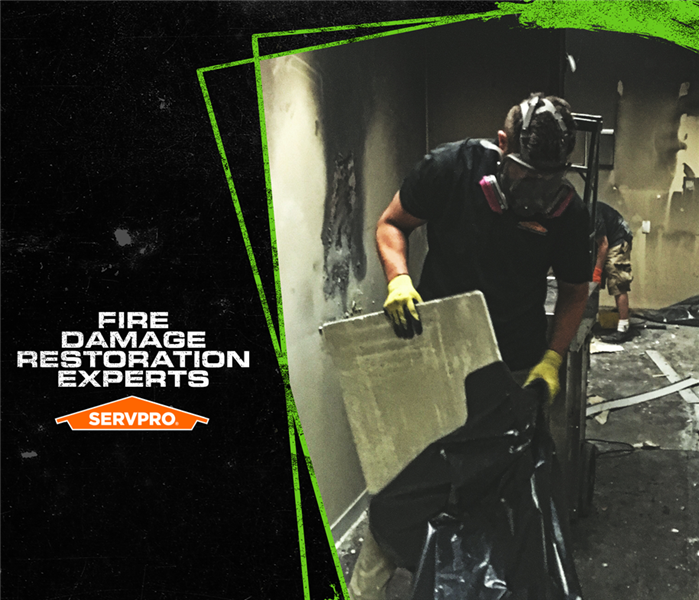 If your Waldorf home has fire damage, call SERVPRO. We'll make it “Like it never even happened.”
If your Waldorf home has fire damage, call SERVPRO. We'll make it “Like it never even happened.”
Restoration Makes Homes in Waldorf Habitable
There are many ways a fire might start in your Waldorf home. SERVPRO® helps local families after disasters like this by taking steps to restore habitable conditions. We are FSRT experts in providing fire damage restoration and clean-up services.
We work as quickly as possible because we understand how stressful and disruptive situations like fire damage in a Waldorf residence can become. The stress and disorder that happens alongside the physical damage in a home can affect every aspect of your family members' lives. At SERVPRO, we understand these issues.
In addition to restoring your home, we can partner with you so the interim period becomes less stressful. These are some of the things that might benefit your family recover faster after a house fire:
- Locating and retrieving personal documents and identification, medical insurance cards, immunization records, prescription medications, and other hard-to-replace items that you most likely need immediately,
- Giving you contact information of agencies that can help provide specific items in the immediate aftermath or
- Immediate cleaning of specific areas to prevent further damage or to allow your family to return home sooner.
The work involved in making everything "Like it never even happened" always takes time after a fire. SERVPRO works in teams to make this faster and more efficient. We follow proven protocols. For example, we use the same methods for odor control after a fire - clean and remove soot, perform thermal fogging, and apply odor-masking scents in problematic locations.
Likewise, everyone uses the same techniques when removing charred materials. For building elements, we measure, mark straight lines, cut along those, and make notations of the required replacements. Doing so reduces waste and controls costs. SERVPRO's goal is to restore your home as quickly as possible.
After a fire, call SERVPRO of Charles County and Oxon Hill at (301) 753-8313. We can streamline the fire damage restoration process for you.
Stopping a Kitchen Fire in Its Tracks | SERVPRO® of Charles County and Oxon Hill
5/19/2023 (Permalink)
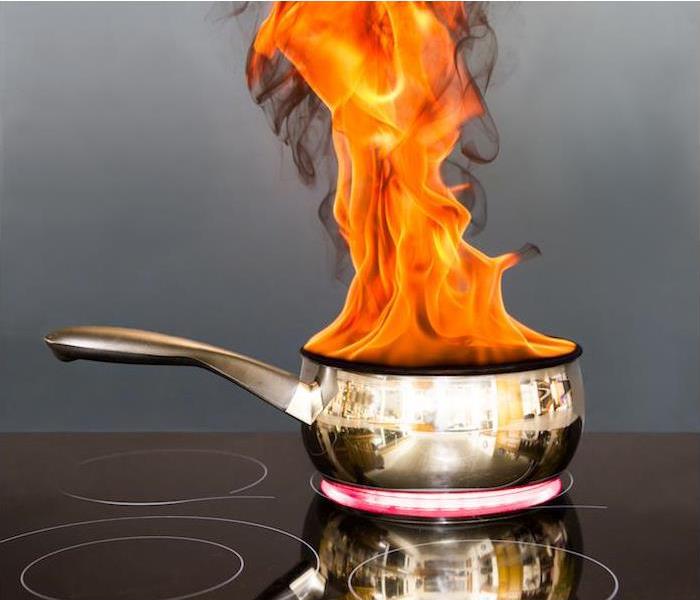 Have you experienced a fire in your home recently? Call SERVPRO of Charles County/Oxon Hill to get your home back in order.
Have you experienced a fire in your home recently? Call SERVPRO of Charles County/Oxon Hill to get your home back in order.
Cooking mishaps are one of the leading causes of home fires and home fire injuries in the United States. Since we often use heat and flame to cook and warm the food we eat, it’s no surprise that accidents happen more often in our kitchens than anywhere else in our homes.
Thankfully, the vast majority of kitchen fires are preventable by staying vigilant and by being responsible while you are cooking.
Responsible Kitchen Practices
One of the smartest things you can do to reduce your risk of a kitchen fire is to stay near your heat source while you are cooking. Even just stepping away for a minute to tend to something is enough time for a spark to catch and spread.
You should also make sure to keep a lid nearby when you are cooking. If a flame starts in a pan, you can quickly smother it with the nearby lid.
In addition, you should try to minimize the amount of flammable materials in your kitchen. Wooden utensils, oven mitts, towels and even the packaging that your food comes in can all catch fire. Keep them far away from your oven or stove top or consider replacing them with fire-resistant alternatives.
When the Flames Spread
If a fire does start in your kitchen, stay calm and call 911 immediately. Even if the fire is relatively small, it can quickly get out of hand.
If it is safe to do so, you can fight the fire by smothering a grease fire or using a fire extinguisher. If you are not comfortable staying to fight the fire, get out! Your safety is the most important thing.
For fires that start in your oven, do not open the door. Shut off the heat and keep the door closed. Just remember, do not throw water on a grease fire. Water and oil don’t mix, and when you introduce water onto burning oil, it can make a bad situation even worse.
Cleaning Up From Fire Damage
OK, so you have either extinguished the fire yourself or the Charles County Fire Department has done it for you. Now what? It’s time to call SERVPRO of Charles County and Oxon Hill! Our fire damage restoration team is ready to help you recover.
We will be with you every step of the way, from removing damaged debris to tackling any lingering smoke odors. Our team can also address repairs that you need and ensure that every inch of your home has been cleaned of residual soot.
Experiencing a house fire can be overwhelming. Let our SERVPRO of Charles County and Oxon Hill team handle your restoration for you.
Fire Safety
8/18/2022 (Permalink)
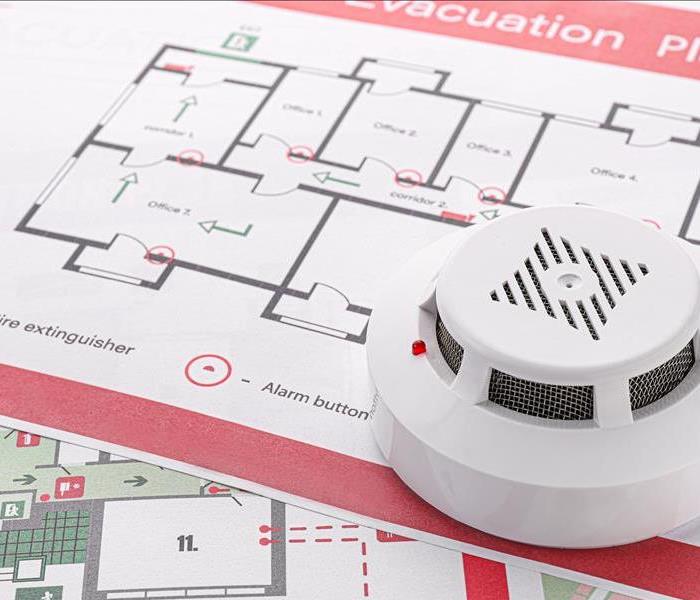 Fire Safety
Fire Safety
SERVPRO® of Charles County is your local Family Owned and Operated Cleaning Restoration Company. While we are experiencing these scorching heat waves, we would like to give you some Fire Safety Tips.
There are house fires every 24 second and that is more than 3,000 fires each day. House fires can be prevented, and unattended cooking is the leading cause of the house fires. Leaving unattended things plugged in which can get hot and cause an electrical fire. Also, make sure you have smoke alarms on every floor and every room in your home.
- Never leave food cooking unattended, especially deep fryers and other frying equipment.
- Avoid using portable and fixed space heaters, as heating equipment is the second leading cause of house fire deaths.
- Create a fire plan that gets you out of your home in less than 2 minutes and practice it.
- Avoid smoking in the house.
Be sure to check your smoke detectors each month and make sure your fire extinguishers are in a place where they are easy to grab, if needed.
To operate a fire extinguisher, remember the word "PASS:"
- Pull the pin. Hold the fire extinguisher with the nozzle pointing away from you and remove the pin to unlock it.
- Aim low. Point the nozzle at the base of the fire.
- Squeeze the lever slowly and evenly.
- Sweep the nozzle from side to side.
If you are faced with an emergency and need assistance call 911. Once your emergency has been controlled please do not hesitate to reach out to SERVPRO® of Charles County and SERVPRO® of Oxon Hill as we are always Here to Help! We will walk you through the cleanup, restoration and reconstruction process and get you back to living life.
We are available 24/7/365 @ 301.753.8313
Holiday Fire Safety Tips
12/20/2021 (Permalink)
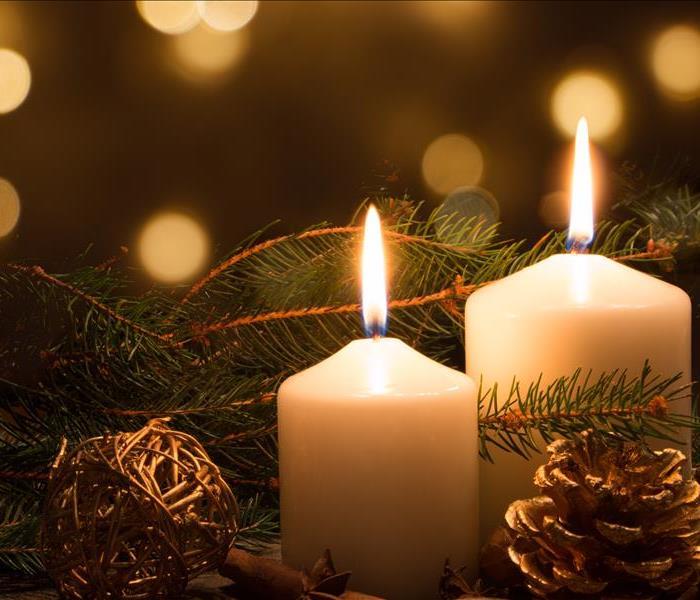 Beautiful Candlelight
Beautiful Candlelight
During the holiday season, warm wishes, family time and good cheer come to mind, however, there are a few precautions that should be remembered because no one wants a reenactment of the infamous National Lampoon’s Christmas Vacation.
Cooking
- In the U.S., most home fires and accidents are cause by unattended cooking.
- Anything that can catch fire must be kept away from the stove and it should be turned off when you leave the kitchen.
- At least three feet around the stove and hot food areas, create a “kid-free zone”.
Heaters
- Create a three feet zone for heating equipment such as furnaces, fireplaces, wood stoves and portable space heaters.
- Turn off portable heaters when leaving the room or going to sleep.
- Never use an oven to heat your home. This is very dangerous and can lead to an electrical fire.
Christmas Trees
- U.S. fire departments annually respond to an average of 160 structure fires caused by Christmas trees. 44% of these fires are caused by electrical problems, and one in five resulted from a heat source that’s too close to the tree.
- Three feet zone rule which suggests that fireplaces, space heaters, radiators, candles and heat vents or lights should be followed for trees as well. Make sure your tree is not blocking an exit.
- Before leaving the home or going to bed, always turn off Christmas tree lights.
Candles
- December is the high month for candle fires.
- Keep candles at least 12” away from anything that can burn, and blow candles out when you leave the room or go to bed.
- More than one third of home candle fires begin in the bedroom or in other areas where people may fall asleep.
Enjoy your holiday season safely!
SERVPRO® of Charles County and SERVPRO® of Oxon Hill
(301) 753-8313
Thank you to the Fire Fighters!
10/19/2021 (Permalink)
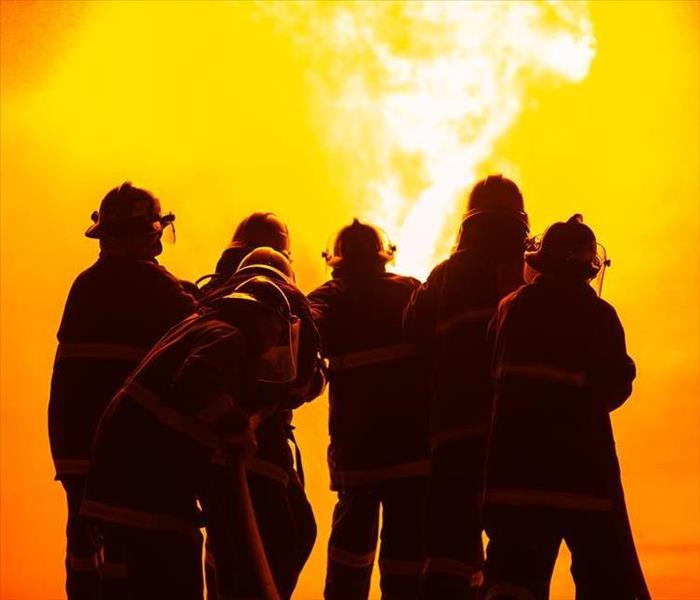 Fearless Firefighters
Fearless Firefighters
October is not only fire prevention month, but it is also a time to honor those strong firefighters that took an oath to protect our communities. The National Fallen Firefighter Foundation was honored to announce their 40th Annual National Fallen Firefighters Memorial during the first weekend of October 2-3, 2021. The memorial service honored the names of 215 firefighter who are now a permanent part of the National Memorial in honor of their sacrifices. Many landmarks and fire departments far and wide across the United States were lit up red to honor our fallen firefighters.
The National Fallen Fire Fighter Foundation is also very dedicated in providing families of the fallen firefighters with important resources, programs, and support as they face a long and difficult journey. Some of the resources and programs include scholarships, wellness conferences, and a remembrance program. We at SERVPRO® of Charles County and SERVPRO® of Oxon Hill salute our firefighters and thank them for their service.
Fire Prevention Month
10/15/2021 (Permalink)
October is fire prevention month. The overall goal of fire prevention month is to raise fire safety awareness and help ensure your home and family are protected. Fire prevention month was established in 1922 by The National Fire Protection Association (NFPA). NFPA along your local firemen celebrate fire prevention month by raising fire safety awareness and educating communities, families, students, and encouraging everyone to practice fire prevention and keep their home and families safe.
The NFPA campaign theme for 2021 Fire Prevention Month is “Learn the Sounds of Fire Safety”. With so many devices in our homes today from safety systems to personal electronics, it is important to be able to distinguish the difference between a potential emergency or push notification. Smoke alarms when triggered make a continuous beeping sound to alert those around of smoke coming from a potential fire. Smoke alarms may also make a chirping noise indicating that the batteries need to be changed. If the alarms continue to chirp after a battery change it may be time to fully replace the smoke alarm with a new one.
SERVPRO® of Charles County and SERVPRO® of Oxon Hill join with the NFPA and firefighters to celebrate National Fire Prevention month and all efforts to keep our community safe!
Be Prepared
8/4/2021 (Permalink)
Did you know that nearly 4,000 Americans die each year in house fires and over 2,000 are severely injured? Having a working smoke detector more than doubles one’s chances of surviving a fire.
The most vulnerable people in fires are the elderly and young. That is why it is so important to teach your children fire safety by creating evacuation plans in the event a fire should occur. They should learn how to exit safely in the event of a fire and basic movements, i.e. stay low, stop drop and roll, etc.
Fire produces gases and fumes that can make you sleepy, weak, and confused. You may not smell these fumes and they won’t wake you, but a smoke alarm will. That is why it is so important to have smoke detectors that work within your home, ideally just outside areas where you sleep. Following a few basic precautions and having a plan may save your life. Be safe!
Home Fire Safety
7/28/2021 (Permalink)
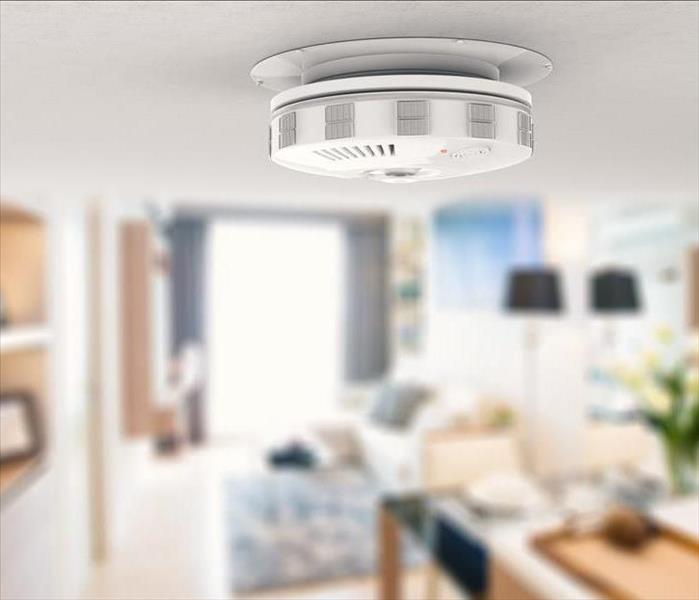 Smoke Detectors Save Lives
Smoke Detectors Save Lives
We have all experienced that annoying beeping noise that you can’t seem to locate in your home no matter how hard you search. You instinctively know that it is the smoke alarm, but for all of your efforts, you can’t pinpoint which one is going off. Well, instead of pulling out the batteries from all of them in frustration, use this time to refresh and replace the batteries for each. This will make sure that all of your smoke detectors are good to go.
This is so important because the Federal Emergency Management Agency, National Fire Academy state that “Three out of five home fire deaths result from fires in properties without working smoke alarms.”*
Additionally, they recommend the following steps:
- Choose interconnected alarms, so when one sounds off, they all do.
- Put smoke alarms outside of each sleeping area and every level of your home.
- Test them and make sure they work.
- Replace the batteries at least annually
- Replace smoke detectors every 10 years
- If you hear the alarm, you may have less than 2 minutes to get out
- Practice fire drills with your family
We hope you have a safe and enjoyable summer and as always, We are Here to Help!
Should You Worry About Kitchen Fires?
4/5/2021 (Permalink)
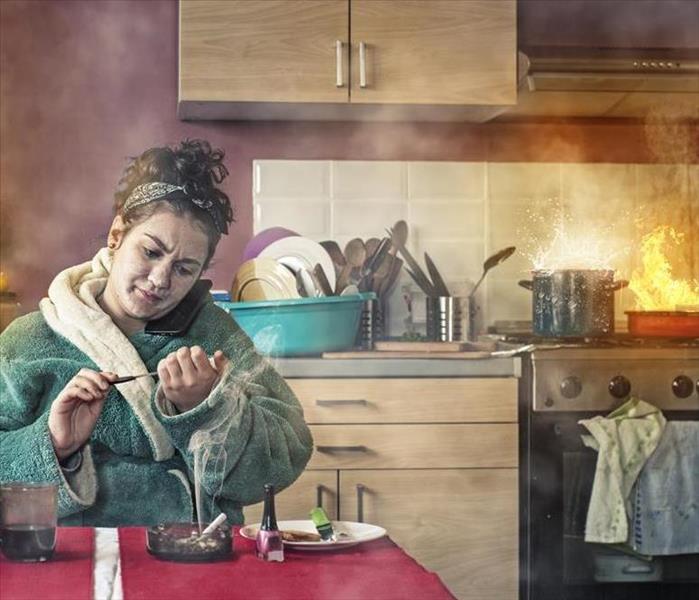 Unattended Kitchen Fire
Unattended Kitchen Fire
According to the National Fire Protection Association (NFPA), cooking accidents resulting in fires are the #1 reason for house fires in the US. It is estimated that around 189,300 home structure fires started each year due to cooking between 2016 and 2018. The leading cause of fires in the kitchen is unattended cooking.
It is more than clear by the above mentioned that Kitchen Fires are not to be taken lightly. Safety tips recommended to prevent a Kitchen fire are:
- Don’t leave your pan. If you have to leave the kitchen, turn the burner off.
- Pay attention. Fires start when heat is too high. If you see smoke, turn the burner off.
- Pot handles should be turned toward the back of the stove so that no one can bump them or pull them over.
- Make sure flammables are away from cooktop. Keep oven mitts, wooden utensils, food packaging, towels or curtains away.
- Keep a pan lid or baking sheet nearby because you can use it to cover the pan if it catches on fire which will put out the fire.
In the event of a kitchen fire:
- Just get out! When you leave, close the door behind you to help contain the fire.
- Call 9-1-1 after you leave.
- If you try to fight the fire, be sure others are getting out and you have a clear way out.
Lastly, if you need help because of fire damage, SERVPRO® of Charles County and SERVPRO® of Oxon Hill are here to help 24 x 7 at (301) 753-8313.
Fire Safety in Fall 2020
11/11/2020 (Permalink)
Fire Safety in Fall 2020
2020 has been a year for the books. In one sense it seems like this has been the NEVERENDING story and on the other hand I cannot believe we are in Fall 2020! Where did the time go? Normally right about now we are winding down from Halloween, preparing for Thanksgiving, and just now getting into the rhythm of the new school year. This year, well it looks a little different.
This year we are figuring out online schooling for our children and wondering if they will ever return to a “normal” school day. We are still actively taking measures to protect our families from the global pandemic, COVID-19 and some of us have returned to work and attempting to find a balance. Crazy right?!?
With all the changes going on around us SERVPRO® of Charles County and SERVPRO® of Oxon Hill feel like it is so important to remind our community to perform their fall safety checks. Here are some reminders to ensure your safety and efficiency this fall!
- Change the batteries and inspect your smoke detectors.
Get in the habit of changing them when the time changes. Spring forward and Fall back will ensure that you never have an inactive smoke detector.
- Have your heating system inspected.
Central Heating systems should be inspected and serviced.
- If you have gas, make sure you have your tank filled and inspect your carbon monoxide detectors.
- If you use space heaters, please make sure to use them responsibly and inspect them for any damage that could pose a risk.
- If you have a chimney have your chimney inspected, repaired, and cleaned each fall if necessary.
With all these tips you are taking an additional step to ensure the safety of your home and loved ones. Fall is also a great time to revisit your family’s evacuation plan and ensure everyone is reminded of what they should do in an emergency.
If you are faced with an emergency and need assistance call 911. Once your emergency has been controlled please do not hesitate to reach out to SERVPRO® of Charles County and SERVPRO® of Oxon Hill as we are always Here to Help! We will walk you through the cleanup, restoration and reconstruction process and get you back to living life.
We are available 24/7/365 @ 301.753.8313 or 301.292.4447.
Thanksgiving Safety Tips 2020
10/20/2020 (Permalink)
Thanksgiving Safety Tips 2020
I know we all have heard the saying, “The kitchen is the heart of the home”, well believe me when I tell you this is true for my family. We all enjoy cooking for our family and others and this time of year offers multiple opportunities to do just that with Thanksgiving, Christmas, and New Year’s right around the corner. This time of year also provides a time to reflect on the year and be joyful for the things you have accomplished as well as set goals for the coming year. During this season we tend to spend a lot more time in the kitchen preparing food and we do not realize the dangers that are associated with this activity.
Did you know that Thanksgiving is the peak day for home cooking fires? Then followed by Christmas Day, Christmas Eve, and the day before Thanksgiving. WOW! Unattended cooking was the leading factor in cooking fires and fire deaths.
Here are the Top 10 Safety Tips to keep in mind this holiday season.
- Stay in the kitchen when you are cooking on the stove top so you can keep an eye on the food.
- Stay in the home when cooking your turkey and check on it frequently.
- Keep children away from the stove. The stove will be hot, and kids should stay three feet away.
- Make sure kids stay away from hot food and liquids. The steam or splash from vegetables, gravy or coffee could cause serious burns.
- Keep knives out of the reach of children.
- Be sure electric cords from an electric knife, coffee maker, plate warmer or mixer are not dangling off the counter within easy reach of a child.
- Keep matches and utility lighters out of the reach of children — up high in a locked cabinet.
- Never leave children alone in room with a lit candle.
- Keep the floor clear so you don’t trip over kids, toys, pocketbooks or bags.
- Make sure your smoke alarms are working. Test them by pushing the test button.
This holiday season enjoy the time with family and friends while also remembering safety. SERVPRO® of Charles County and SERVPRO® of Oxon Hill is Always Here to Help if you need us, but we hope that you don’t and you can enjoy each moment with family and friends.
Fire Safety Month- 2020
10/7/2020 (Permalink)
October is Fire Safety month and let’s face it, 2020 has caused us all to focus a lot more on safety than ever before. SERVPRO® of Charles County and SERVPRO® of Oxon Hill are always Here to Help if you have an emergency, but we would like to HELP before an emergency occurs.
Maryland public schools are currently operating on a virtual learning platform due to the COVID-19 Pandemic, which gives us a little more time at home with our children. This would be the perfect time to discuss Fire Safety and possibly even create some cool activities to make sure everyone knows what to do in the case of an emergency.
Here are some ideas to get the creative mind working!
I know you remember when you were in school and the fire drill would sound and everyone would STOP, GASP and MOVE! (For me it always seemed to occur right when I was really getting into something good in class!) We can recreate those in our homes. If you know your kid has a break from on screen learning between 11:30 and 12:30 plan a fire drill. Set an alarm and BOOM! Everyone to their places. This will ensure that everyone knows what to do and where to go in case of a real emergency.
No, I am not talking about those really cool new places that are popping up in a town near you! I am talking about a real escape plan for each room in your home. The entire family should be involved in the creation of your family's escape plan. They should know exactly what to do, where to go and honestly, they should know what NOT to do. Example: I tell my daughter that in the case of an emergency we will meet at the mailbox. I also explain to her that if I do not show up to the mailbox that she is to stay there until help arrives. DO NOT COME BACK TO THE HOUSE. I explain this because I could have to go out the back door and walk all the way around the property to get to her and if she doesn’t stay there she is causing more danger for our entire family.
If you have smaller children some of these discussions can be overwhelming, scary and just plain hard to understand for them. Try printing out coloring pages and talking about the pictures. One thing that worked when my daughter was little is, I drew our escape plan and let her color it. As she colored each room, the yard etc. we discussed what the different paths looked like. This also prompted us to go around the house and spot all the fire extinguishers. This was an easy way for her to understand and comprehend our safety plan.
These are just some ideas on how to make sure that our community and your family are prepared in the case of an emergency. Here at SERVPRO® of Charles County and SERVPRO® of Oxon Hill we find it most important to try and educate our community and be a wealth of knowledge. If 2020 has taught us one thing it is that safety, health, family and community are especially important in times of crisis, and we want to be a vital part of each one!
If you need help, have questions or have experienced damage to your home, please do not hesitate to contact us immediately. We are available 24 hours a day, 7 days a week and 365 days a year! Someone from our office is always Here to Help!
SERVPRO® of Charles County
(301) 753-8313
SERVPRO® of Oxon Hill
(301) 292-4447
FIRE- Smoke and its behavior in your home!
7/31/2020 (Permalink)
The flames of a fire are the thing that we are most worried about during an active fire because they are scary, for a lack of better term. We know the flames are damaging our property and threatening our safety but smoke damage is the sneaky partner to flames. Smoke inhalation is just as dangerous as actual flames. Smoke is what makes the cleanup process complicated due to the different types of smoke and soot residue.
When SERVPRO® arrives on the scene of a fire we are going to first asses the situation to determine our plan of action. We will need to determine the type of smoke so that we can clean accordingly. There are different types of smoke and SERVPRO® of Charles County and SERVPRO® of Oxon Hill are trained to handle them all.
WET SMOKE: (Plastic and Rubber) Low heat, smoldering, high odor and smears. Smoke webs are more difficult to clean.
DRY SMOKE: (Paper and Wood) Fast burning, high temperature- heat rises so the smoke will as well.
PROTEIN FIRE: Virtually invisible, discolors paints and varnishes and has extreme odor.
FUEL SOOT: Often caused from puff backs and can seem overwhelming, but SERVPRO® has you covered.
OTHER: Special losses need special care. Some things in this category would be fire extinguisher residue, fingerprint powder and tear gas.
No matter what your situation is SERVPRO® of Charles County and SERVPRO® of Oxon Hill are Here to Help!
Summer 2020 Fire Tips
6/29/2020 (Permalink)
With the presence of the global pandemic, COVID-19, we are seeing more and more families opting for outdoor vacations. Camping can be a fun way to still enjoy summer while reducing exposure to COVID-19. Personally, I am not the camping (in a tent) type but I am even considering this for my family as we NEED a summer getaway!
Here are some summer campfire safety tips!
Most campgrounds have posted rules in place. These rules can vary from campground to campground because of the risk associated to the specific areas. It is important to take the time to review them with your family and ensure that they understand the rules.
Make sure that your family is aware of the generational lesson, STOP DROP and ROLL! This phrase has been heard for years and it is important to make sure that your family understands this phrase! Practice what this looks like.
If grilling or starting a campfire, assess your surroundings. Make sure you are in a safe spot away from fire hazards. Check the wind direction and make sure there is enough room between trees and camping materials.
If starting a campfire, make sure you always have supplies nearby to extinguish the fire if things take a turn for the worse. Water, fire extinguisher, sand, shovel etc. could be the difference between a scare and a catastrophe.
COVID-19 has caused us to be aware of our surroundings and we should continue this practice when it comes to Summer Safety as well!
Fire Extinguisher Safety and Information
4/3/2020 (Permalink)
A fire extinguisher is a lifeline in an emergency fire situation when used correctly. NFPA recommends remembering the phrase PASS!
P Pull the pin. Hold the nozzle away from you.
A Aim low towards the base of the fire.
S Squeeze the trigger evenly and slowly to control the release.
S Sweep the nozzle from side to side.
You should always read the instructions on a fire extinguisher before an emergency happens. Being comfortable with the use of this device could save your family, your property and your life!
It is also important to know that there are different classes of fire extinguishers specifically designed for certain types of fires.
CLASS A: This is the most common type of fire extinguisher as it used to put out normal items such as cloth, wood, rubber, paper and many plastics.
CLASS B: This should be used on fires involving flammable liquids such as grease, gas and oil.
CLASS C: This is designed for fires involving appliances, tools and other products that are plugged in.
CLASS D: Class D is normally found in factories and warehouses as they combat fires involving metals.
CLASS K: This type is seen in commercial kitchens as it fights fires involving vegetable oils, animal oils or fats in cooking appliances.
Please take the time to educate yourself, your family and your staff about Fire Extinguisher Safety! Please know that SERVPRO® of Charles County and SERVPRO® of Oxon Hill is always Here to Help! You can call us 24/7/365 @ 301-753-8313.
The United State Fire Administration: Carbon Monoxide
12/2/2019 (Permalink)
The United State Fire Administration: Carbon Monoxide
Carbon Monoxide is very dangerous as you cannot see or smell it but it can kill you in minutes. Often referred to as the silent killer, Carbon monoxide is invisible, odorless and colorless. The United States Fire Administration has offered some tips to protect yourself from Carbon Monoxide.
- Have fuel burning appliances inspected by trained professionals every year.
- Open the damper before using fireplace.
- Never use oven or stove top to heat your home.
- Make sure all fuel burning appliances are vented outside.
- If you need to warm up your vehicle remove it from the garage.
- Only use grills outside away from vents, windows and doors.
- Only use portable generators outside away from vents, windows and doors.
It is estimated that more than 400 Americans die, 20,000 visit the hospital and 4,000 are admitted to the hospital due to CO poisoning. Symptoms of CO poising include dull headache, weakness, dizziness, nausea/vomiting, shortness of breath, confusion, blurred vision and loss of consciousness.
SERVPRO® of Charles County and SERVPRO® of Oxon Hill ask you to please be aware and safe when it comes to the potential of CO poisoning and your home!
Space Heater Safety
11/18/2019 (Permalink)
Space Heater Safety
Home fires, deaths and injuries are frequent during the winter months. Heating is the second leading cause of winter home fires and space heaters are often the cause or involved in 40% these fires. Space heaters come in handy during the winter months, especially in my home with a basement and hardwood floors! BRRRR.
Safety is a main concern when using space heaters this winter. Below you will find some space heater safety tips to keep you and your family protected this winter.
- Make sure your space heater has been tested by a recognized laboratory
- Read instructions and warning labels before using
- Inspect all visible wires for damage
- NEVER leave heater unattended
- Proper placement of space heaters is critical. They should be 3 ft away from anything.
- Plug heaters directly into wall outlet- never use extension cord
- Always place heaters flat and level. NEVER place on tables or cabinets.
Please protect your family and property this winter. If you need our services you can call us 24 hours a day- 7 days a week at 301.753.8313.
Fire- Fire escape Plans are a MUST!
10/8/2019 (Permalink)
Fire- Fire escape Plans are a MUST!
When a fire occurs your ability to get out is significantly greater with advanced warning from smoke alarms and with a fire escape plan in place. Seven, 7, people die everyday from a home fire and the thought of that is scary in itself.
Fire is so unpredictable and can spread so rapidly that you are often left with, on average, 2 minutes to exit safely. Having an escape plan and practicing with your family could be a lifesaver! Design an escape plan for each room in the home and discuss regularly. Have fire drills at home to make sure that everyone is aware and remembers how to respond and where they should be going.
Children in the home should have visual aids and have at least two exit plans. There should be a meeting point for the entire family in a safe place away from the home.
Placing a working flashlight in each room is a great way for anyone who would be trapped to signal to firefighter in an emergency. This will allow the firefighters to locate them in a timely manner even through the smoke.
SERVPRO® of Charles County and SERVPRO® of Oxon Hill offer free emergency ready plans in case of a disaster, 301.753.8313.
Summer Grilling Safety Tips
9/16/2019 (Permalink)
Summer Grilling Safety Tips
Summer as we all know is our favorite time to break out the grill and enjoy the wonderful food with friends. Grilling is fun when hanging with friends or just cooking for your family, but it can be dangerous. Here are some grill safety tips that can be overlooked easily but can save you a catastrophe.
- Only use your grill outside and keep it at least 3 feet away from siding, deck rails and eaves.
- Always keep children and pets at least 3 feet away from your grill.
- Open your gas grill before lighting.
- Keep an eye on your grill and never walk away from it.
- Clean your grill after each use. This will remove grease that can start a fire.
- Place the coals from your grill in a metal can with a lid once they have cooled.
SERVPRO® of Charles County and SERVPRO® of Oxon Hill wants you to enjoy a safe and fun summer!
Dryers can be dangerous
8/30/2019 (Permalink)
Fire- Dryers can be dangerous.
Doing laundry seems like one of the safest tasks you would complete in your home, right? Unfortunately, that may not be the case. Clothes dryers are the cause of over 20,000 house fires each year! Regular maintenance and cleaning could protect your family and your home. Here are some dryer safety tips from SERVPRO® of Charles County and SERVPRO® of Oxon Hill.
- Clean your lint trap before each use
Did you know that lint build up is combustible? Lint causes fires! Cleaning the lint trap is one of the easiest things you can do, simply remove the screen and wipe lint from the screen and surrounding edges. There is also a dryer lint brush that will allow you to reach areas you cannot reach by hand.
At least once a year it is recommended to have your dryer vents cleaned. Cleaning your dryer vent includes cleaning the exhaust vents and all hoses. If you still have a white or silver vinyl duct hose replace it immediately as they are flammable. SERVPRO® of Charles County and SERVPRO® of Oxon Hill does provide dryer vent cleanings along with duct cleanings.
- Understand how to safely use your dryer
If your clothing has gasoline, oil or any other dangerous materials make sure to wash clothing well before putting in the dryer. Dangerous materials are combustible even with the slightest heat. Be aware of the materials you are storing near the dryer. Never leave dryer running when no one is home.
- Make sure your dryer is installed correctly
When installing or having your dryer installed you should always make sure that the dryer vent runs OUTSIDE. Dryer vents should never vent inside your home or attic. A dryers exhaust duct should not exceed 25 feet from the dryer location. The electrical outlet used to power your dryer should be a 220v grounded electrical outlet. A professional should be completing the install for gas dryers.
SERVPRO® of Charles County and SERVPRO® of Oxon Hill are always Here to Help! You can call us 24 hours a day, 7 days a week @ 301.753.8313 or 301.292.4447.
Heating Safety Tips
8/1/2019 (Permalink)
HEATING SAFETY TIPS FROM SERVPRO® of Charles County and SERVPRO® of Oxon Hill
Keep anything flammable at least three feet away from heating equipment, like the furnace, fireplace, wood stove or a portable space heater. Have a three foot “kid-free zone” around open fires and space heaters.
Make sure the fireplace has a sturdy screen to stop sparks from flying into the room. Ashes should be cool before putting them in a metal container. Keep the container a safe distance away from your home.
Remember to turn portable heaters off when leaving the room or going to bed.
Test smoke alarms monthly.
Always use the right kind of fuel, specified by the manufacturer, for fuel burning space heaters.
Have heating equipment and chimneys cleaned and inspected every year by a qualified professional.
If your property does suffer fire damage, contact SERVPRO® of Charles County, 301.753.8313 or SERVPRO® of Oxon Hill, 301.292.4447 today!
Electrical Safety Tips
7/15/2019 (Permalink)
Electrical Safety Tips
Electrical cords, receptacles and light bulbs can be very dangerous. Every year these things cause 41,000 residential fires, 350 deaths, 1,400 injuries and $620 Million in property damages. Here are SERVPRO® of Charles County and SERVPRO® of Oxon Hill we would like to offer you some electrical safety tips.
Extension Cord Safety Tips
- Never run a cord under a rug
- Only use them for temporary situations
- Damaged cords should be replaced immediately as they can cause shock or fires.
- Only buy approved safety cords
- Never overload the extension cord based on rating label
Receptacle Safety Tips
- Replace broken receptacles right away
- Never alter the plug
- If you must use a grounding adapter first verify the plug is grounded
- Do not use multi plug adapters for extended periods
- Never install 3 slot receptacles where a ground is not available
- Use child safety plugs when children are present
5 Most common commercial fires
7/1/2019 (Permalink)
With the abundance of industrial areas in Charles County and Oxon Hill we feel it is important to address the five most common causes of commercial fires are…
- Combustible Dust Fires
A combustible dust is any dust or fine material that has the potential to catch fire and explode when it is mixed in the air. Many times, materials that are normally considered non-flammable can act as a combustible when fine particles are mixed with air in a particular concentration. Combustible dust happens in two waves. A primary explosion causes particles to become airborne, and then the dust cloud can ignite and cause a secondary explosion, much more severe than the first. Combustible dust can bring down entire facilities.
How do I Prevent Combustible Dust Fires?
- Implement a hazardous dust inspection, testing, housekeeping, and control program.
- Regularly inspect for dust residues in open and hidden areas.
- Use proper dust collection systems.
- If ignition sources are present, use cleaning methods that do not generate dust clouds.
- Control smoking, open flames, and sparks (mechanical and friction).
- Hot Work Fires
Hot work is any activity that involves open flames or generates sparks or heat. This includes welding, heat treating, grinding, thawing pipes, torch cutting, brazing, soldering, etc. Hot work becomes a fire hazard when sparks and molten material travel…often as far as 35 feet, sometimes igniting combustible dust in other areas.
How do I Prevent Hot Work Fires?
- Train personnel on the hazards associated with hot work and make sure they are using proper safety equipment.
- Clear area of flammable materials including dust, gases, and liquids.
- Make sure a safety professional is on site to provide supervision of the work.
- Avoid hot work if possible.
- Flammable Liquid and Gas Fires
These are most common in chemical plants. Flammable liquids and gases can ignite off sparks from the previous hazards or add fuel to an already burning fire.
How Do I Prevent A Flammable Gas Fire?
- Know the hazards of each flammable liquid and gas on-site. Read and follow the safety information for storage and follow the material safety data sheet included with the product.
- Properly store hazardous materials according to OSHA.
- Keep ignition sources away from flammable gases and liquids.
- Provide personal protective equipment, like gloves, bodysuits, vests, goggles, shoes etc.
- Equipment and Machinery Fires
Equipment not properly installed, maintained, or operated correctly is a major cause of industrial fires. This is especially true for equipment associated with hot work and heating. Even machinery not seen as a fire hazard can become a risk with lack of proper maintenance.
How Do I Prevent Equipment and Machinery Fires?
- Training can help employers and employees identify possible risks and what to do if they find one.
- Keep the machines, equipment, and areas surrounding them, clean.
- Prevent machine overheating by following the manufacturer’s guidelines for recommended maintenance procedures.
- Electrical Hazard Fires
Electrical fires are most common in manufacturing plants and include wiring that is exposed or not up to code, overloaded outlets, extension cords, overloaded circuits, static discharge, etc. A spark from electrical hazards can cause ignition of combustible dust and flammable liquids and gases.
How Do I Prevent Electrical Hazard Fires?
- Don’t overload electrical equipment or circuits.
- Unplug temporary equipment not in use.
- Avoid using extension cords.
- Use antistatic equipment as advised by OSHA and NFPA.
- Follow a regular cleaning schedule to ensure combustible dust and other hazardous materials are removed from areas that house equipment and machinery.
The importance of cleaning dryer vents!
6/14/2019 (Permalink)
The importance of cleaning dryer vents!
According to FEMA, failure to clean home dryers causes 34% of home dryer fires each year. Home dryer fires cause $35 million in property loss and can even cause injury or death. To reduce the risk of these fires happening in your home, SERVPRO® of Charles County and SERVPRO® of Oxon Hill can help clean dryer vents and air ducts that may have lint buildup or other blockages.
Other tips for keeping your dryer vents clean from the National Fire Protection Agency include cleaning the lint filter before and after each load, making sure the outdoor vent flap will open and is not restricted by snow, a bird’s nest or other potential obstacles on a regular basis.
Don’t risk the safety of your family and home! For more information on cleaning dryer vents and air ducts, contact SERVPRO® of Charles County, 301.753.8313 or SERVPRO® of Oxon Hill, 301.292.4447 today!
Do You Have Dirty Ducts?
6/1/2019 (Permalink)
Do You Have Dirty Ducts?
In some circumstances, such as after a fire, smoke, or suspected mold growth, duct cleaning becomes an essential part of the cleanup process. In these cases, SERVPRO® of Charles County and SERVPRO® of Oxon Hill can often restore the HVAC system and duct work to pre-damage condition.
If you have a fuel-burning furnace, stove, or fireplace, the U.S Environmental Protection Agency (EPA) recommends they be inspected for proper functioning and be serviced before each heating season to protect against carbon monoxide poisoning.
The SERVPRO® Duct Cleaning System is proven and cost-efficient. Unlike the majority of duct cleaning services, your SERVPRO® uses a portable ventilation and air duct cleaning system to examine ductwork and make a clean sweep, removing years of dust and grime.
- The process begins by using patented equipment, including a roto-scraper, which automatically adapts to the duct’s shape and diameter while traveling through the duct, removing debris and filth before vacuuming begins.
- Next, a powerful push-pull air delivery and collection system transfers the debris from the ducting to a 16-gallon container.
- Air is filtered through a HEPA filtration system, removing 99.97 percent of the particles in the airstream. HEPA filters capture debris and keep the indoor environment clean.
- As an optional process, a sealant or coating product may be sprayed to address odor or microbial concerns. Filters will either be cleaned or replaced to remove odor and dirt.
For more information on duct cleaning, or the schedule an appointment, contact SERVPRO® of Charles County and SERVPRO® of Oxon Hill @ 301.753.8313!
Class Types of Fires
5/1/2019 (Permalink)
Not all fires are the same. Per NFPA 10, burning may be classified into one or more of the following fire classes and your fire protection specialist will select the right fire extinguisher size and agent for the hazard.
Class A
Class A fires are fires in ordinary combustibles such as wood, paper, cloth, rubber, and many plastics.
Class B
Class B fires are fires in flammable liquids such as gasoline, petroleum greases, tars, oils, oil-based paints, solvents, alcohols. Class B fires also include flammable gases such as propane and butane. Class B fires do not include fires involving cooking oils and grease.
Class C
Class C fires are fires involving energized electrical equipment such as computers, servers, motors, transformers, and appliances. Remove the power and the Class C fire becomes one of the other classes of fire.
Class D
Class D fires are fires in combustible metals such as magnesium, titanium, zirconium, sodium, lithium, and potassium.
Class K
Class K fires are fires in cooking oils and greases such as animal and vegetable fats.
Some types of fire extinguishing agents can be used on more than one class of fire. Others have warnings where it would be dangerous for the operator to use on a particular fire. Please read all warning labels and attempt to educate yourself in case of an emergency. Being prepared in these situations can reduce the risk of injury as well as reduce the amount of damage. In the event of a fire call SERVPRO® of Charles County- 301.753.8313 or SERVPRO® of Oxon Hill- 301.292.4447 today!
SERVPRO® of Charles County and SERVPRO® of Oxon Hill Fire and EMS Service
4/1/2019 (Permalink)
SERVPRO® of Charles County and SERVPRO® of Oxon Hill Fire and EMS Service
Charles County Maryland is in the Southern Central part of Maryland with 643 Square miles of land and 185 square miles of water. The estimated population is 159,700 as of 2017. Charles County 12 all-volunteer fire departments and 14 all-volunteer Emergency Medical Service organizations. There is also an all-volunteer Dire-Rescue team within the county. There is also a 911 Communications Headquarters Center in La Plata, MD.
In 2018 there were 9,674 fires in Charles County Maryland with the highest month being April 2018 with 1266. This is an alarming number in general but especially when you think about the damage and stress caused by these fires.
SERVPRO® of Oxon Hill helps Accokeek, Brandywine, Clinton, Fort Washington, National Harbor, Oxon Hill and Temple Hills as well. In our territory we have five (5) Volunteer Fire Departments that we are able to assist with fire damage.
With the new construction at the National Harbor and MGM at National Harbor our volunteer Fire Fighters and EMS personnel stay busy.
This is where SERVPRO® of Charles County comes in to provide an excellent level of customer service and make this process as seamless as possible. Our Technicians are properly trained in Fire & Smoke Restoration through IICRC. We take pride in making sure that we can handle each scenario and provide a sense of comfort knowing your home or business is in good hands.
If you have experienced a fire or smoke damage give us a call today! 301.753.8313.
Fire preparedness
3/1/2019 (Permalink)
As children, we have been told repeatedly what to do in case there is a fire in our homes. These lessons stay with us and help keep everyone safe. Between having working fire alarms to an emergency escape plan, ourselves as individuals have made it very important to not only prevent fires, but safely live through one if it happens. Something that is not brought up in school lessons a lot is fire safety for the elderly or individuals with access or functional needs. For those individuals, it may be hard or physically impossible for them to follow emergency escape plans that have been set up due to having different needs. Luckily, there are ways to accommodate so that they themselves are safe in the event of a fire.
Smoke Alarms are very loud and are a clear indicator that there is a fire present somewhere in the house but what would you do if you were hearing impaired? In that case, a smoke alarm with a flashing strobe light or vibrations are available. For visually impaired individuals, they have a smoke alarm that has paused in between each cycle so you would be able to hear any verbal instructions someone else in your home could tell you. Additionally, there are smoke alarms that can be connected to a strobe light outside the home to alert neighbors that there may be a fire and you need assistance.
Fire escape plans are very important, even more important that they are planned out and tested. If you have a wheelchair or a walker, you want to be sure that you can get through the doorways safely in the case of evacuation. Another thing the consider if is there are accessible ramps by the exit doors to assist your evacuation. If you live in an apartment building or a multi-leveled home, it may be best for you to live on the ground floor. Not only does it decrease your escape time, but if you are physically impaired if may safe your life. In the event of a fire, elevators are shut off leaving a stairway as the only means of transportation to the ground floor level. Make sure that you let your family, neighbors, and property manager know of your special needs and fire plan, so they know how to assist you if the time ever comes. Additionally, always keep a phone on you or near your bed just in case. Safety is something to be considered for everyone and is something that needs to be taken very seriously. Your life is too valuable to be lost to a fire.
Let SERVPRO® of Charles County Destroy Odors with Deodorization
10/1/2018 (Permalink)
Let SERVPRO® of Charles County Destroy Odors with Deodorization
Even a small fire can cause odors for years to come if the affected areas are not properly cleaned and deodorized. Fire, smoke, and soot damage in your home or business can create unpleasant and potentially permanent problems.
As various material burn, the smoke produced travels throughout the structure, leaving odorous residues and deposits on surfaces and in hard to reach places. Unless fast, professional action is taken, these residues and deposits can cause permanent damage to contents and may result in resurfacing odors.
With technicians certified by the Institute of Inspection, Cleaning and Restoration (IICRC), SERVPRO® of Charles County provides specialized services that can rid your home or business of offensive odors left by fire or smoke damage. SERVPRO® professionals do not cover up lingering odors with fragrance; we seek out and remove the sources of the odor.
If you suffer a fire damage or some other accident and require deodorization services, contact SERVPRO® of Charles County at 301.753.8313. Whether it’s fire, water, or Mold damage, or just a stubborn odor that refuses to go away, we’ll help make it “Like it never even happened.”
Summer Ready
9/1/2018 (Permalink)
SERVPRO® of Charles County IS “Ready for whatever happens.”
YOU CAN BE TOO THIS SUMMER
Each year, families and friends across the country enjoy the summer months with barbecues, camping trips, or by cooling off in a pool or lake. To enjoy these occasions, it is important to keep safety top of mind to ensure you have fun in the sun.
According to a recent study by U.S Consumer Product Safety Commission, nearly 11,900 Americans were injured by fireworks in 2015, with the majority happening in the month surrounding the Fourth of July. Another 8,700 are injured by charcoal/wood-burning and propane grill fires. A grill should always be supervised when in use. Keep children and pets a safe distance from the grilling area to prevent accidental burns or tipping of the grill.
Grills also cause an average of 8,900 home structure or outdoor fires. “These fires cause an annual average of 50 civilian injuries and $2 million in direct property damage,” according to the National Fire Protection Association (NFPA).
If you enjoy lounging by the pool or going for a boat ride to cool off from the summer sun, make sure you exercise caution, especially when children are present. Only swim in approved areas and supervise children at all times when near the water.
The summer season should be a time to make memories and enjoy the great outdoors. Don’t become a statistic. Take precautions to prevent these events from putting a damper on your summer months!
Smoke Alarms: Life Savers
7/30/2018 (Permalink)
Smoke Alarms: Life Savers
Smoke alarms save lives when properly installed and maintained, according to the National Fire Protection Association (NFPA).
In homes, smoke alarms should be in every bedroom and on every level, including the basement. In office and commercial environments, check your state requirements or contact your local Fire Marshall to help ensure all codes are met.
Test smoke alarms monthly using the test button. Smoke alarms with non-replaceable batteries need the entire smoke alarm unit replaced every ten years. Other alarms need batteries replaced every year, and the unit replaced every ten years. If the alarm chirps signaling low battery, take the proper steps to replace the unit or the batteries immediately. Never disable or remove the batteries from an alarm. Almost half of fires where smoke alarms were present but did not activate had missing or disconnected batteries (NFPA).
In larger commercial facilities, hard wired or wireless smoke alarms offer benefits such as not needing to be tested as often and activating throughout the entire building if smoke is detected in just one area (NFPA).
If you need help installing, testing or changing batteries in your smoke alarms contact your local fire department, an electrician or the American Red Cross.
Be sure your home or workplace has a fire emergency plan in place and conduct regular fire drills. For more information on Emergency Preparedness, contact SERVPRO® of Charles County at 301.753.8313.
EMERGENCY FIRE DAMAGE TIPS for Charles County, MD
7/2/2018 (Permalink)
EMERGENCY FIRE DAMAGE TIPS for Charles County, MD
These emergency tips will assist you in taking proper action until SERVPRO® of Charles County arrives. Follow these DO’s and DON’Ts to help reduce damage and increase the chances of successful restoration.
DO:
- Limit movement in the home to prevent soot particles from being embedded not the carpet and avoid tracking.
- Keep hands clean. Soot on hands can further soil upholstery, walls, and woodwork.
- If electricity is off, empty freezer and refrigerator completely and prop doors open to prevent odor.
- Wipe soot from metal kitchen and bathroom faucets, trim and appliances.
- If heat is off during the winter, pour RV antifreeze in sinks, toilet bowls, holding tanks, and tubs to avoid freezing pipes and fixtures.
- Remove soot particles from plants with damp cloth.
- Change HVAC filter, but leave system OFF until a trained professional can check the system.
- Tape double layers of cheesecloth over air registers to stop particles of soot from getting in or out of the HVAC system.
DON’Ts:
- Don’t attempt to wash any walls or panted surfaces without first contacting SERVPRO® of Charles County.
- Don’t attempt to shampoo carpet, rugs, or upholstered furniture without first consulting SERVPRO® of Charles County.
- Don’t attempt to clean and electrical appliances such as TV, radios etc., that may have been close to fire, heat, or water. Consult an authorized repair service.
- Don’t consume any food or beverages that may have been stored close to fire, heat, or water. They may be contaminated.
- Don’t turn on ceiling fixtures if ceiling is wet. Wiring may be wet or damaged and cause electrical shock, and air movement may cause secondary damage.
- Don’t send garments to the dry cleaner. Improper cleaning may set in smoke odor.
When fire and water damage take control of your life, SERVPRO® of Charles County will help you take it back.
Summer Fire Safety Tips From FEMA
6/21/2018 (Permalink)
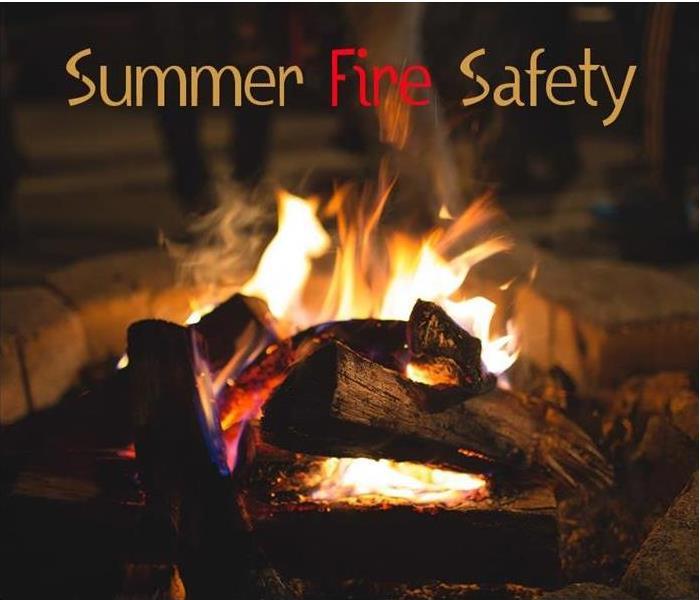 Summer Fire Safety
Summer Fire Safety
Summer Fire Safety Tips From FEMA
Release date: June 29, 2011Release Number: R10-11-22SEATTLE, Wash. -- As skies clear and weather turns warmer, Pacific Northwest residents are hoping for glorious weather this Fourth of July. But however the weather turns out, the Federal Emergency Management Agency (FEMA) and the U.S. Fire Administration (USFA) warn that careless handling of fireworks and outdoor grills can ruin parties and picnics -- and entire summers. In 2010, U.S. hospital emergency rooms treated an estimated 8,600 people for fireworks-related injuries, and according to FEMA Regional Administrator Ken Murphy, 73 percent of fireworks injuries occurred between 18 June and 18 July.
"When celebrating the Fourth of July, Americans need to remember to use fireworks, fires and barbecues with care. The best way to enjoy fireworks is to visit public displays held by trained professionals," said Murphy. "Summer holidays should be fun and generate good memories, not pain and remorse. Have fun, but be safe."
FIREWORKS SAFETY TIPS:
If fireworks are legal where you live and you decide to set them off on your own, be sure to follow these important safety tips:
- Observe local laws.
- Keep a bucket of water handy in case of a malfunction or fire.
- Read and follow all warnings and instructions.
- Never allow children to play with or ignite fireworks.
- Be sure other people are out of range before lighting fireworks. Never shoot a firework at or near another person.
- Only light fireworks on a smooth, flat surface away from the house, dry leaves, and flammable materials.
- Never try to relight fireworks that have not fully functioned. Douse and soak them with water and throw them away.
- Never ignite fireworks in a container, especially a glass or metal container.
- Keep unused fireworks away from firing areas.
- Store fireworks in a dry, cool place. Check instructions for special storage directions.
GRILLING FIRE SAFETY TIPS
- Propane and charcoal BBQ grills must only be used outdoors. If used indoors, or in any enclosed spaces such as tents, they pose a fire hazard and a risk of exposing occupants to deadly carbon monoxide poisoning.
- Place the grill a safe distance from lawn games, play areas, and foot traffic. Grills should be positioned at least 10 feet away from siding, deck railing, and out from under eaves and overhanging branches.
- Keep matches, lighters, and starter fluid out of the reach of children in a locked drawer or cabinet.
- Keep children and pets away from the grill area: declare a three-foot "kid-free zone" around the grill.
- Use long barbeque mitts and long-handled grilling tools to protect the chef from heat and flames when cooking.
- Periodically remove grease or fat buildup in trays below the grill so it cannot be ignited by a hot grill.
USFA, part of the Federal Emergency Management Agency, serves the American public and the nation's fire services through training, data collection and analysis, public fire education, and fire protection technology research. For more information, visit: www.usfa.fema.gov. For wildfire preparedness tips, sample preparedness plans and emergency checklists, visit firewise.org or www.fema.gov.
Last Updated: January 3, 2018 - 12:19
SPRINGTIME TIPS TO REDUCE FIRE RISK
3/1/2018 (Permalink)
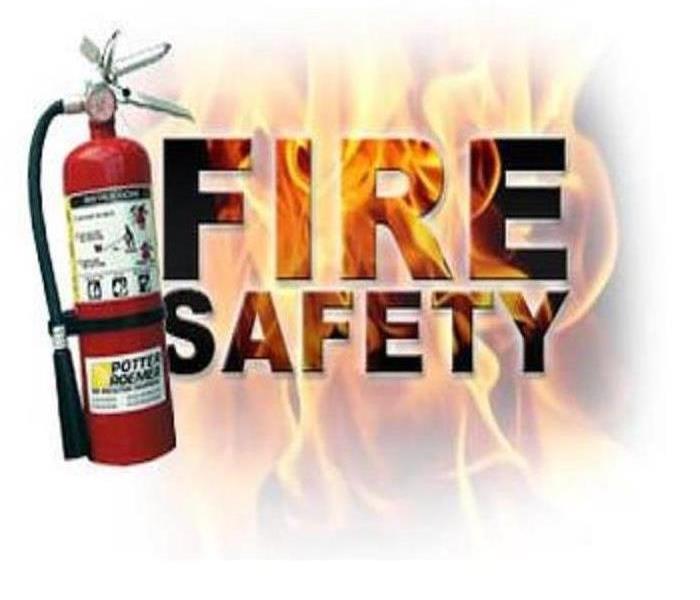 Fire Tips
Fire Tips
SPRINGTIME TIPS TO REDUCE FIRE RISK
We have come a long way in preventing house fires and their associated injuries and deaths over the last 40 years. For example, in 1977, 723,500 house fires resulted in nearly 5,900 civilian deaths and $10.2 billion in damage. In 2013, there were just 369,500 house fires, 2,700 civilian deaths and $6.8 billion in property damage. Within our individual communities and neighborhoods, we need to do everything we can to bring those numbers down even further.
There is no way to eliminate house fires completely. However, there are steps we can all take to make our homes safer and to reduce the risk of injuries and deaths should a house fire occur.
Spring is a great time to start thinking about fire safety. You are already in spring cleaning mode, so why not take the spring months to do some simple things that can reduce your fire risk. Below are some easy-to-implement tips along with a brief explanation of how wireless home security can help.
Check Your Smoke Alarms
Fire departments around the country take advantage of the start of daylight saving time to encourage people to check the batteries in their smoke alarms. Your smoke alarm should have a test button that you simply press to make sure the battery is working. If not, replace the battery with a fresh one.
If your smoke alarms are hardwired to your home’s electrical system, they still need to be checked. They can fail from time to time. Also, be aware that sometimes hardwired smoke alarms are temporarily disconnected for whatever reason. Make sure yours are not.
Check Electrical Outlets and Cords
Electrical outlets and cords take a beating during the winter months because we are inside for longer hours, resulting in more frequent use of electrical appliances. While you clean, give each of your outlets (and the cords plugged into them) a quick inspection to make sure everything is okay. Do the same for exterior electrical outlets as well. They can sometimes suffer damage from winter weather.
Replace Extension Cords
If you have been utilizing extension cords in your home for long-term purposes, spring is the time to change that. Extension cords are meant to be temporary only. So, if you have one that has been plugged in for months, it is better to run wiring to install a new outlet so the extension cord can be eliminated.
Remove Unnecessary Flammables
Your spring cleaning will undoubtedly involve the garage – if you have one. A good thing to pay attention to in the garage is the existence of flammables including gasoline and charcoal lighter fluid. If there are any flammables you no longer need, check with your county or city to make arrangements to properly dispose of them. Those you do intend to keep should be sealed in approved containers and kept in a cool place.
How Wireless Home Security Can Help
If you are not already utilizing home security, spring is a great time to look into it. The most basic of systems usually includes both burglary and fire monitoring at a very reasonable price. The advantage of fire monitoring is that it keeps track of your home even when you are not there. Monitoring also allows for quicker response times because monitoring centers can immediately notify local first responders.
Reducing the risks associated with house fires is no accident. It takes a concerted effort among homeowners to keep themselves and their families as safe as possible. We hope you will utilize these tips in combination with installing a wireless home security system with fire monitoring.
Timeline of Smoke/Fire Damage
11/16/2017 (Permalink)
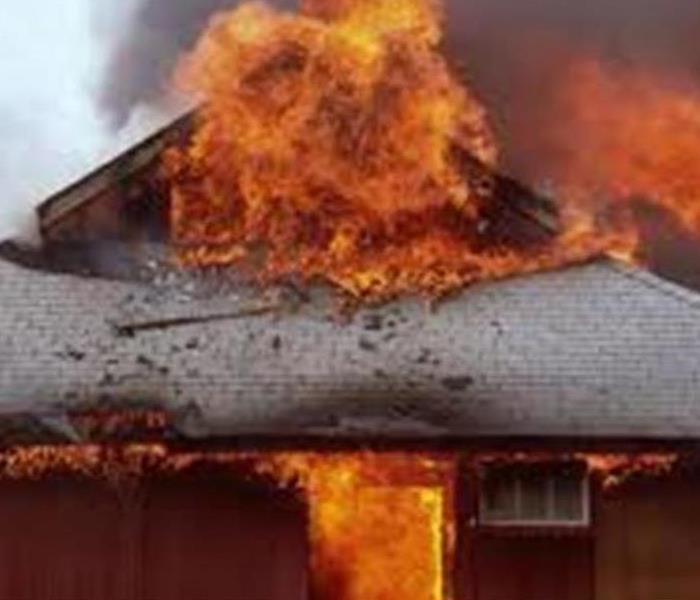 FIRE
FIRE
Timeline of Smoke/Fire Damage
In the wake of a fire that has covered homes with smoke and ash, it’s important to begin clean up as soon as possible in order to prevent permanent damage or discoloration from soot residue. The IICRC provides the following tips for fire victims facing clean up:
- Practice safety first. Use a dust mask (like painters use) and gloves as you work.
- Ventilate the home. Place a box fan in an open window to draw the air and dust out.
- Clean from top to bottom. Start with the ceilings, walls and fixtures, and work your way down to the contents of the room, then to the floor.
- Vacuum floors and upholstery. Make sure your vacuum cleaner has a high efficiency filter. Otherwise, you risk blowing soot back into the air.
- Some draperies, clothing and machine-washable items may be laundered. Use a mild alkaline cleaner to neutralize the acid in the soot. Fine clothing should be dry cleaned.
- Most exterior walls (brick, stone, wood, paint, siding) and eaves can be cleaned by spraying with a detergent, agitating soot with a soft-bristled brush, pressure washing from bottom to top, then rinsing from top to bottom.
- If the damage and residue are heavy, it may be best to hire a professional to thoroughly restore your home and belongings.
- Check with your insurance company to see if smoke damage from outdoor sources is covered by your policy.
- If the fire has warped or distorted the structure, consult a licensed general contractor.
Professional restoration technicians know that damage increases and restoration costs escalate the longer neutralization, corrosion control and cleaning is delayed. When homeowners prolong the restoration of their home, they extend the effects brought on by the smoke exposure. The following is a timeline of the effects of fire and smoke on a home.
Within Minutes: Acid soot residues cause plastics to yellow; small appliances located close to the source of combustion discolor; highly porous materials (marble, alabaster) discolor permanently.
Within Hours: Acid residues stain grout in bathrooms; fiberglass bath fixtures may yellow; uncoated metals tarnish, counter tops may yellow; finishes on appliances, particularly refrigerators, may yellow; furniture finishes may discolor.
Within Days: In time, acid residues cause painted walls to yellow permanently; metal corrodes, pits and rusts; wood furniture requires refinishing; vinyl flooring requires refinishing or replacement; clothing becomes soot stained; upholstery stains permanently.
Within Weeks: Restoration costs escalate tremendously. Synthetic carpet fibers may yellow or discolor permanently; silver plate is corroded permanently; glass, crystal, china may require replacement due to severe etching and pitting caused by prolonged exposure to acid soot residues.
Cleaning up soot residue must be done as quickly as possible. During combustion, soot residue and volatile vapors are carried by rising and expanding air to surfaces throughout a structure, and are deposited. This process occurs repeatedly until combustion ends, with soot residue building up on surfaces layer by layer. By the time restoration technicians arrive, lacquer-like soot residue may be quite difficult to dissolve and remove.
In addition to removing residue, ridding your home of its smoky odor is necessary. Professionals use this four-step process to remove odors:
- Remove the source of the odor, as possible, including unsalvageable debris that contributes to odor generation and recontamination of cleaned and deodorized areas.
- Clean salvageable surfaces and items to physically remove odor-causing residue.
- Chase remaining odor with an odor counteractant. In the case of smoke, create a deodorizing fog or gas that seeks out and combines with odor-causing substances.
- Seal salvageable surfaces that are inaccessible or slightly scorched, not only for aesthetic purposes, but primarily to encapsulate odor and prevent progressive recontamination.
Understanding the effects of a fire can help homeowners evaluate the damage to their home. By learning more about residue clean-up and deodorization after a fire, you can minimize the need for costly repair. Fire and smoke restoration experts can help you return your home and furnishings to a “preloss” condition.
Charles County- Fire Safety
10/27/2017 (Permalink)
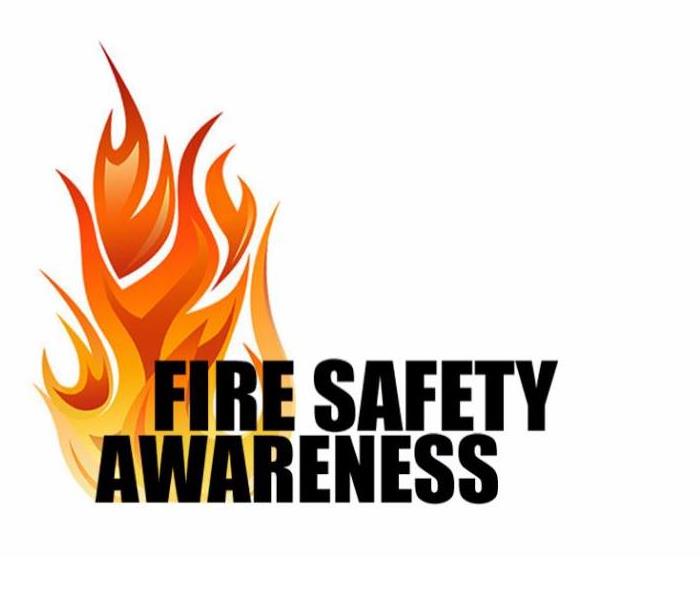 Fire Safety
Fire Safety
This week I was alerted to an unoccupied house fire in our area and as I arrived on scene it was still an active fire. As I sat down the street (out of the way) my eyes began to fill with tears. The images of the brave men and women working to contain and stop this fire brought back memories of a fire I personally went through and a flood of emotions. There were your typical emotions such as fear, sadness and hope but there was also a sense of pride. I was proud to be a part of a community where our volunteer fire fighters serve selflessly to help others. To see these men and women working together to save this home was amazing. It is not often that we get to see these guys in action and when I did it was amazing, but it also sparked the thought process of fire safety.
SERVPRO® is known for the cleanup and restoration of house fires but we are also proactive in helping create an emergency plan. Safety is very important and we try to talk to everyone about being prepared in case of an emergency. The safety and well being of our community is a vital part of our business. We want people to be knowledgeable, safe and prepared. Does your family have a fire safety plan? Do your kids know EXACTLY what to do and do you practice? If you do not please let us know!
Top Tips for Fire Safety
- Install smoke alarms on every level of your home, inside bedrooms and outside sleeping areas.
- Test smoke alarms every month. ...
- Talk with all family members about a fire escape plan and practice the plan twice a year.
- If a fire occurs in your home, GET OUT, STAY OUT and CALL FOR HELP.
The 4 most common types of fire
9/18/2017 (Permalink)
 Kitchen Fire is #1
Kitchen Fire is #1
The 4 most common types of fire
Kitchen, electrical, heater and smoking-related fires are the four most common types of fires
Dec 21, 2011
While fires can start at anytime and anywhere, below are descriptions of the four most common types of fires. Acknowledging these types of fires may help you to reduce or even eliminate the risk of starting a fire.
1. The most common type of fire in the U.S. is the kitchen fire. The reason that the kitchen is the source of many fire hazards is because the kitchen is where heat, electricity, water, and grease come together.
The most common type of kitchen fire is the grease fire. A grease fire is extremely dangerous as it can get out of control quickly and spread from the stove throughout the kitchen and into other rooms of the house.
Many grease fires occur because someone leaves a frying pan on the stove unattended. They also occur when someone overheats a pan during attended cooking if the grease catches fire. Grease fires can cause serious injury and extensive property damage.
Other types of kitchen fires include oven fires and appliance fires. Fires can also get started in the kitchen when electricity comes in contact with water.
2. Electrical fires are another common type of fire. Electrical fires are caused by a number of different factors, including faulty appliances, worn or faulty electrical wiring, improper use of electrical outlets and worn out breaker boxes.
Older homes often do not have the proper wiring to handle the amount of electrical appliances in use today. Often old wiring inside walls becomes frayed or worn, causing shorts and sparks that can ignite.
Old breaker boxes are made to shut off electrical current when the circuit becomes overloaded as a fire prevention measure, but often the connections are worn or broken and do not activate the breaker switch.
Lighting is another cause of electrical fires, which can be triggered by improper wiring or the use of bulbs that are higher in wattage than the amount recommended for the lighting appliance.
3. Heater fires are among the most common types of fires in the months of December, January and February. Portable heaters should always have automatic shutoffs that activate when they overheat as a fire precaution.
Coil space heaters are especially hazardous because the coils will ignite anything combustible nearby. Always keep any type of space heater a minimum of three feet from anything combustible. That includes curtains, bedding, clothing and furniture. Always shut space heaters off when you’re not in the room.
Extension cords should not be used with space heaters as they generate too much electricity and can start a fire.
4. Another major type of fire is smoking-related. Fires caused by cigarettes account for 1,000 deaths in the U.S. every year. Many times the smoker is not the person who dies.
Most smoking fires are started by embers igniting on furniture, bedding and trash cans. Smokers should always be sure cigarettes are completely extinguished before emptying ashtrays into the trash.
Never smoke in bed and never smoke when you are tired, inebriated, or drowsy from medication. Do not place ashtrays on flammable surfaces like couches, chairs, or beds where they can tip over and start a fire.
The best way to prevent smoking-related fires is to smoke outside the house and have a can filled with sand to extinguish cigarette butts.
References:
www.Fire-Extinguisher101.com
www.RestorationSOS.com
Facts About Smoking and Home Fires (pdf)
Four Seasons of Safety
9/18/2017 (Permalink)
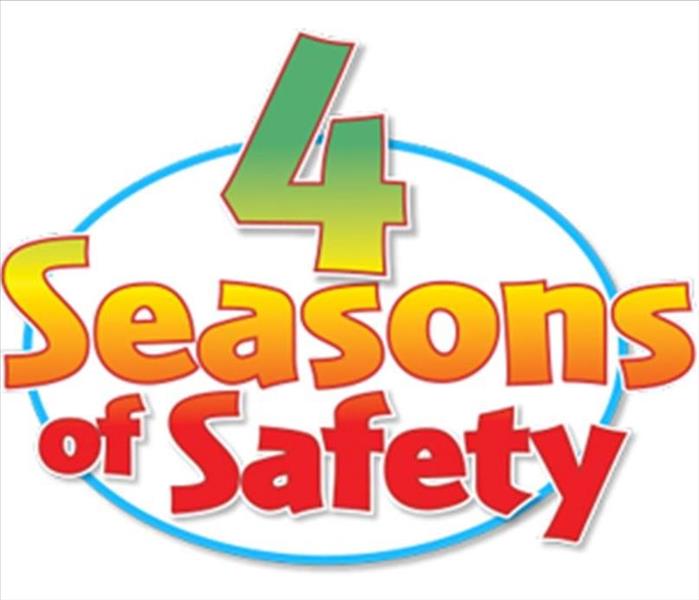 4 Season of Safety
4 Season of Safety
Four Seasons of Safety
Each season of the year has unique fire and electrical safety dangers that are related to common seasonal activities. The 4 Seasons of Safety program includes tips, lessons and activities that help students learn about basic fire and electricity concepts while also providing critical safety information that helps them learn to identify and prevent the fire and electrical safety hazards. All included activities can be conducted without the need for additional resources or supplies and with little to no advance preparation required.
The program also includes valuable family involvement opportunities. Take-home resources empower students to share the safety information they have learned with their families.
The 4 Seasons of Safety program resources are appropriate for students in grades 3-5 and have been developed to align with the following educational standards:
Mid-continent Research for Education and Learning (McREL)
- Science Standard 9
- Health Standard 5
National Science Teachers Association (NASTA) National Science Education Content
- Standard B Physical Science
- Standard F Science in Personal and Social Perspectives
Common Core English Language Arts Standards – Reading: Informational Text
- CCSS.ELA-Literacy.RI.3.8
- CCSS.ELA-Literacy.RI.4.7
- CCSS.ESL-Literacy.RI.5.9
Fire Prevention and Electrical Safety Classroom Toolkit: Each section of the toolkit includes two seasonal lessons and safety tips along with information to help you tailor the activities to your grade level.
Classroom Poster: Display this colorful poster in a prominent place in your classroom as a constant reminder of the steps we can take to stay safe all year long.
4 Seasons of Safety Interactive White Board Activities
The 4 Seasons of Safety program includes tips, lessons and activities that help students learn about basic fire and electricity concepts while also providing critical safety information that helps them learn to identify and prevent the fire and electrical safety hazards. All included activities can be conducted without the need for additional resources or supplies and with little to no advance preparation required. Available in ".Notebook" format.
Funding for this program was provided by a 2012 Fire Prevention and Safety (FP&S) Grant from the Department of Homeland Security / Federal Emergency Management Agency.
Keeping kids safe from fire
8/31/2017 (Permalink)
Keeping kids safe from fire
The U.S. Fire Administration (USFA) reviews and collects resources for you to use in your public outreach activities to keep children safe from fire. Explore these materials to learn more about discussing fire safety with parents, teachers and other caregivers.
Prevention and safety messages to share
Make an escape plan
It is important to have a plan when there are children in your home. Children sometimes need help getting out of the house. They may not know how to escape or what to do unless an adult shows them.
- Have a plan for young children who cannot get outside by themselves.You will need to wake babies and very young children and help them get out. In your plan, talk about who will help each child get out safely.
- It is important to find two ways out of every room in your home, in case one exit is blocked or dangerous to use.
- Choose a meeting place outside your home.Children should know what to do when they hear a smoke alarm and there is no adult around. Help them practice going to the outside meeting place. Teach them to never go back inside a building that is on fire.
Keep children safe from fire and burns
Some children are curious about fire. There are simple steps you can take to keep you and the people you love safer from fire and burns.
- Keep children 3 feet away from anything that can get hot.Space heaters and stove-tops can cause terrible burns. Keep children at least 3 feet away from stoves, heaters or anything that gets hot.
- Keep smoking materials locked up in a high place.Never leave cigarette lighters or matches where children can reach them.
- Never play with lighters or matches when you are with your children.Children may try to do the same things they see you do.
Smoke alarms save lives.
8/31/2017 (Permalink)
Smoke alarms save lives.
65% of home fire deaths happen in homes with no smoke alarms at all or no smoke alarms that work. When there is a fire, smoke spreads fast and you need smoke alarms to give you time to get out.
Safety Tips
- Install smoke alarms in every bedroom, outside each separate sleeping area and on every level of the home, including the basement. Interconnect all smoke alarms throughout the home. When one sounds, they all sound
- An ionization smoke alarm is generally more responsive to flaming fires and a photoelectric smoke alarm is generally more responsive to smoldering fires. For the best protection, either types of alarms or a combination alarm (photoelectric and ionization) should be installed in homes.
- Test alarms at least monthly by pushing the test button.
- Smoke rises; install smoke alarms following manufacturer’s instructions high on a wall or on a ceiling. Save manufacturer’s instructions for testing and maintenance.
- Replace batteries in all smoke alarms at least once a year. If an alarm “chirps,” warning the battery is low, replace battery right away.
- Replace all smoke alarms, including alarms that use ten year batteries and hard-wired alarms, when they are ten years old or sooner if they do not respond properly when tested.
- Be sure the smoke alarm has the label of a recognized testing laboratory.
- Alarms that are hard-wired (and include battery backup) must be installed by a qualified electrician.
- If cooking fumes or steam sets off nuisance alarms, replace the alarm with an alarm that has a “hush” button. A “hush” button will reduce the alarm’s sensitivity for a short period of time.
- An ionization alarm with a hush button or photoelectric alarm should be used if the alarm is within 20 feet of a cooking appliance.
- Smoke alarms that include a recordable voice announcement, in addition to the usual alarm sound, may be helpful in waking children through the use of a familiar voice.
- Smoke alarms are available for people who are deaf or hard of hearing. These alarms use strobe lights. Vibration equipment can be added to these alarms.
- Smoke alarms are an important part of a home fire escape plan.
Emergency Preparedness for Owners of Pets and Service Animals
8/31/2017 (Permalink)
Emergency Preparedness for Owners of Pets and Service Animals
Every disaster plan must include your pets. If you know disaster is imminent, bring your pet inside immediately. Get your animals under control as quickly as possible, either using a leash or by putting them in a pet carrier. Disasters often strike suddenly, while you are away from home. You can improve your pet’s chances for safety if you leave him/her inside, with collars and identification tags, when you go out.
Consider an arrangement with a trusted neighbor who would be willing to evacuate your pets in your absence. Make sure the person knows your animals, can locate your emergency supplies, and has a key to your home. Provide him or her with instructions and phone numbers on how to reach you. Keep your animal’s license and identification current. Keep up-to-date identification on your pets at all times. Use a properly fitting collar with an identification tag.
Consider using a microchip for identification, but make sure local shelters have microchip scanners. Keep current color photographs of your pet, showing any distinguishing markings, with your emergency supplies. If you evacuate, take your pet. Your animal’s best protection is to be with you. Remember, taking your pet with you requires special planning. Locate a safe place for your pets before disaster strikes. Evacuation shelters generally do not accept animals for public health and safety reasons. Service animals, on the other hand, are allowed to accompany their owners to an emergency shelter. Call hotels and motels in your immediate area and a reasonable distance from home to see if they will accept pets and under what conditions. Also, contact local boarding kennels and veterinary hospitals with boarding facilities. Ask friends and family members whether they will provide foster care for your pets.
NOTE:
Animal shelters will provide temporary foster care for owned pets in times of disaster, but this should be considered only as a last resort. Emergency Supplies Kit Assemble a portable pet emergency supplies kit to provide for your pet’s needs for seven days. Pack the supplies in a carry case, in case you evacuate.
Include the following:
- Medications and medical records, including vaccination records (stored in a water proof container) and a first aid kit. Name and telephone number of your veterinarian. List medical conditions and special considerations.
- Sturdy leashes, harnesses, and carriers to transport pets safely and ensure that your animals can’t escape.
- Current photos of your pets in case they get lost.
- Food, portable water, bowls, cat litter and pan, and can opener.
- Plastic bags/paper towels for disposing of animal waste.
- Favorite toys and pet beds with kennel or carrying case.
- Maintain a list of emergency contact numbers in the kit. Even with a disaster plan in place, pets and their owners can sometimes run into trouble, or a disaster can exceed local resources. Visit the Humane Society of the United States for more information, www.hsus.org.
Charles County Smoke and Soot Cleanup
8/9/2017 (Permalink)
 Smoke and Soot Damage Can Cause a Pervasive Odor in Your Charles County Home.
Smoke and Soot Damage Can Cause a Pervasive Odor in Your Charles County Home.
Smoke and soot is very invasive and can penetrate various cavities within your home, causing hidden damage and odor. Our smoke damage expertise and experience allows us to inspect and accurately assess the extent of the damage to develop a comprehensive plan of action.
Smoke and soot facts:
- Hot smoke migrates to cooler areas and upper levels of a structure.
- Smoke flows around plumbing systems, seeping through the holes used by pipes to go from floor to floor.
- The type of smoke may greatly affect the restoration process.
Different Types of Smoke
There are two different types of smoke–wet and dry. As a result, there are different types of soot residue after a fire. Before restoration begins, SERVPRO of Charles County will test the soot to determine which type of smoke damage occurred. The cleaning procedures will then be based on the information identified during pretesting. Here is some additional information:
Wet Smoke – Plastic and Rubber
- Low heat, smoldering, pungent odor, sticky, smeary. Smoke webs are more difficult to clean.
Dry Smoke – Paper and Wood
- Fast burning, high temperatures, heat rises therefore smoke rises.
Protein Fire Residue – Produced by evaporation of material rather than from a fire
- Virtually invisible, discolors paints and varnishes, extreme pungent odor.
Our Fire Damage Restoration Services
Since each smoke and fire damage situation is a little different, each one requires a unique solution tailored for the specific conditions. We have the equipment, expertise, and experience to restore your fire and smoke damage. We will also treat your family with empathy and respect and your property with care.
Have Questions about Fire, Smoke, or Soot Damage?
Call Us Today – 301.753.8313
 Team SERVPRO has the certification, experience and the tools to tackle the fire damage situation in your home. Contact us day or night, 24/7.
Team SERVPRO has the certification, experience and the tools to tackle the fire damage situation in your home. Contact us day or night, 24/7.





 24/7 Emergency Service
24/7 Emergency Service




